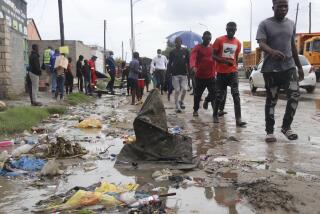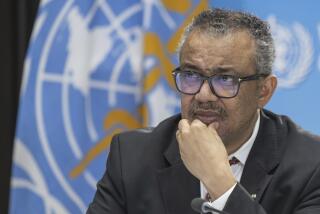Global Development: World Malaria Day brings a call to help prevention: ‘Zero malaria starts with me’

One poster shows a mother and child in Myanmar holding antimalarial medicine. Another features an insecticide spray operator in Mozambique. A third focuses on a community health worker in the Democratic Republic of Congo.
In each case, the images are accompanied by large bold letters reading: “Zero malaria starts with me.”
As part of World Malaria Day on Thursday, agencies including the World Health Organization are promoting an awareness campaign to help eliminate the disease, which infects millions of people each year via mosquitoes. It can cause fevers, headaches or nausea and, if left untreated, can result in death.
The campaign includes a social media component much like the posters to provide quick reminders of how to prevent or treat the disease. It also provides guidance on where to find information on malaria.
“The world has made incredible progress against malaria, but we’re still too far from our goal, a world free of malaria,” said Dr. Tedros Adhanom Ghebreyesus, director-general of WHO.
The latest efforts involve calling on political leaders, the private sector and communities to do all they can to improve prevention, diagnosis and treatment, he said.
The WHO and the African Union Commission have partnered with others in a grass-roots campaign, officials said, that embraces the “Zero malaria starts with me” theme, which began in Senegal in 2014. World Malaria Day, which began in 2008, evolved from Africa Malaria Day, which began in 2001.
During the past few years, progress in reducing the number of malaria-related deaths worldwide has slowed, worrying organizations and government leaders in countries that see a high level of cases.
While many countries have eliminated the disease, others still face a high number of cases and deaths related to the curable disease. The WHO’s latest annual report on the state of malaria across the globe listed five countries where nearly half of all cases occurred — Nigeria, the Democratic Republic of Congo, Mozambique, India and Uganda.
The latest data from WHO estimated about 435,000 people worldwide died as a result of malaria in 2017, and there were a total of 219 million cases that year in 87 countries. The United States and many other countries have succeeded at eliminating malaria.
Here are some things to know about the disease and the progress made over the years in reducing malaria-related deaths.
Who is most affected
Malaria is caused by the Plasmodium parasite, which is transmitted to humans by the bites of infected mosquitoes. WHO estimates that nearly half of the world’s 7.5 billion population was at risk of malaria as of 2017.
The disease mainly affects people with weakened immune systems, said Dr. Ken Staley, the U.S. global malaria coordinator of the President’s Malaria Initiative. Pregnant women and children under 5 are among the most vulnerable. In 2017, children younger than 5 made up 61%, or 266,000, of reported deaths. A child dies every two minutes, according to the World Health Organization.
Children with severe cases might suffer from respiratory distress or cerebral malaria, which can lead to seizures or other neurological abnormalities, according to the Centers for Disease Control and Prevention.
In general, malaria is a curable disease if it is diagnosed and treated properly, but it can be fatal.
An ancient disease
Malaria has plagued ancient populations and dates back thousands of years. At least two presidents — George Washington and Abraham Lincoln — were struck by the disease.
In 1942, the U.S. created the Office of Malaria Control in War Areas, which preceded the CDC, to reduce the disease’s effect during World War II at military training bases and in southern parts of the country. The country was declared malaria-free in 1949.
Recent estimates from the CDC suggest the U.S. still sees about 1,700 cases annually, mostly from travelers. The CDC urges U.S. residents to buy antimalarial drugs before a trip and to take preventive measures while traveling.
The effort to fight it
A majority of malaria cases and deaths occur in sub-Saharan Africa, according to WHO.
From 2000 to 2015, international efforts to decrease deaths and cases were successful. In 2006, 881,000 people died from malaria, compared to 435,000 in 2017, according to WHO estimates.
But WHO’s 2018 report indicates the world is not on track to achieve a previously set goal of reducing malaria deaths and disease by at least 40% by 2020, as progress has stalled in the past few years.
What’s being done
Some organizations and governments are continuing to support countries carrying a high burden of malaria through life-saving resources and funding.
According to WHO’s 2018 report, the U.S. provided the most financial support for the effort, contributing $1.2 billion in 2017. In total, $3.1 billion was invested by governments of malaria-endemic countries and international partners to combat the disease, the report said.
Some of the more effective preventive methods include providing insecticide-treated nets and spraying insecticide on interior walls to kill mosquitoes.
Last year, the President’s Malaria Initiative funded treatment in more than 5.7 million homes, protecting about 21 million people.
In 2018, the initiative distributed 61 million nets, 65 million doses of antimalarial treatment and 15 million doses of seasonal malaria chemoprevention treatments for children.
On Tuesday, WHO announced Malawi was the first of three countries in Africa to roll out the world’s first malaria vaccine, known as the RTS,S, for children up to age 2. The program aims to reach about 360,000 children every year in Ghana, Malawi and Kenya.
“This is a day to celebrate as we begin to learn more about what this tool can do to change the trajectory of malaria through childhood vaccination,” Dr. Matshidiso Moeti, WHO Regional Director for Africa, said in a statement.
Since 2007, nine countries, including the United Arab Emirates, Morocco and Turkmenistan, have been certified by WHO as having eliminated malaria. The most recent country to eliminate malaria was Uzbekistan.
Staley said there is confidence among those working to beat malaria.
“It’ll be a long fight,” Staley said, “but we can eliminate malaria from the globe.”
More to Read
Start your day right
Sign up for Essential California for news, features and recommendations from the L.A. Times and beyond in your inbox six days a week.
You may occasionally receive promotional content from the Los Angeles Times.







